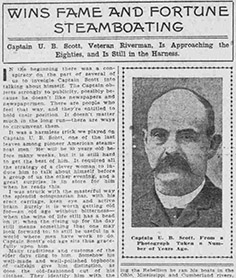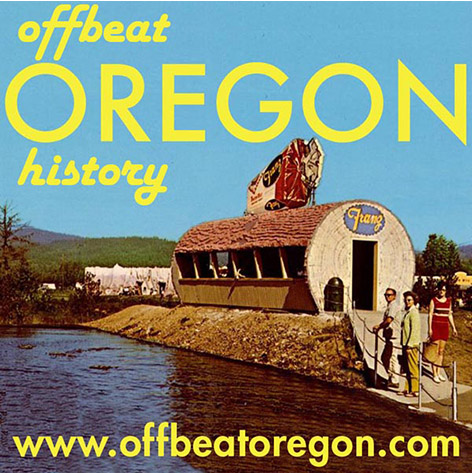CONTINUED FROM THE PRINT EDITION:
Riverboat monopoly’s clever coup a big mistake
The boat, when complete in 1881, was christened the Fleetwood. It was well named; the Fleetwood was the fastest thing on the river, and would be until the next Scott-designed boat, the Telephone, was launched. Scott, it was clear, was really good at designing hulls. The Fleetwood was built specially for the run upriver to the foot of the Cascades rapids — the location, today, of the town of Cascade Locks. It was an immediate huge hit. Taking the Fleetwood shaved quite a bit of time off of a trip upriver. A couple years later, another screw-driven steamer was launched in the river above the Cascades rapids to provide a connection for the Fleetwood’s passengers and bring them the rest of the way to The Dalles. This was the Gold Dust, and it was owned by Scott’s friend and fellow Ohio steamboat captain Ernest Spencer, the former skipper of Scott’s City of Salem. After that, passengers on the Fleetwood no longer had to use ORN riverboats for the second leg of the journey. They could make the whole trip on fast, luxurious Scott-designed boats. A fare war ensued. Passage to The Dalles got as low as 50 cents on ORN boats. But still passengers packed the Fleetwood. Apparently it was worth the extra money it cost. Scott then turned his attention to the Portland-Astoria run, which was very much the most popular and lucrative run on the river. And because there was no ORN-controlled chokepoint on that run, the boat on that run could also carry freight. So he started work on the sternwheeller that would become the Telephone. But before the Telephone was ready, something rather interesting happened. ORN reached out to Captain Spencer and made him an offer that was too generous to ignore. Their goal, clearly, was to get Scott off the river so they could return their pricing to “normal” levels. Doubtless they thought this was a clever coup. They’d leave the Fleetwood on the lower river in place, but they’d jack up fares from Cascade Locks to The Dalles so that they would make their money anyway. Plus, they could negate the Fleetwood’s speed advantage by arranging their schedule so that its passengers had to wait around the docks for several hours. They wouldn’t like that; there were very few amenities there, just docks and the portage road. Scott was very unhappy about this development, but he doesn’t seem to have blamed his old friend for taking the deal, so it must have been a pretty sweet one. But it did force him to make a crucial business decision. The default decision would be to do nothing, and continue trying to provide passenger service as far as Cascade Locks. The problem was, if he did that, he would be operating entirely at ORN’s mercy. Or ... he could abandon the upriver service entirely and put the Fleetwood on the Portland-Astoria run immediately. It’s clear that ORN did not think this through. No successful entrepreneur would be satisfied with providing a service that’s entirely dependent on the charity and goodwill of his biggest competitor. But by this time, the decisionmakers at ORN probably weren’t entrepreneurs themselves; they were company men. They probably thought Scott would run his boat for a few marginally profitable months and then give up and sell the operation to them at a fire-sale price, which would give them free reign on the river and a really superior boat to boot.
|

Soon the Fleetwood was making the run from Portland to Astoria. This was a run for which ORN charged passengers $5 — this at a time when many working Oregonians made less than $5 a month. Scott priced his service at $2. Crickets started chirping in the Oregon Railway and Navigation Co. ticket booth. Not only was the Fleetwood far cheaper than the competition, it was more luxuriously appointed and considerably faster. Passengers shaved several hours off their travel time by choosing Scott’s boat. In fact, Scott probably could have charged $6 a head and still packed ’em in, because the Fleetwood represented a premium service. The competitors settled into a new equilibrium on the lower river, in which ORN was for once the junior player. The erstwhile monopoly had to console itself by squeezing the farmers and traders who rode its boats and trains back and forth from The Dalles and points east. But the Portland to Astoria route was the biggest and most profitable direct run on the river, and ORN probably found itself wishing it had left Scott alone on his Cascades run. That was especially the case after the Telephone was ready — the sternwheeler Scott was building specifically for that run. Scott put it on the line immediately, and it made the run even faster than the Fleetwood, plus it could carry freight. Of course, that left the Fleetwood available; but rather than going back to squabbling over the upriver run, Scott sent it around to Puget Sound and started making speed runs between Seattle and Tacoma. It was a very successful line, and Scott soon expanded his operations in the sound to a level that dwarfed his Oregon offerings. As the era of the sternwheel riverboat came to an end, Scott’s company operated the most famous riverboat on the Columbia — the enormous, plush and speedy Bailey Gatzert, known to those who found its wake excessive and annoying as the “Daily Bastard,” the only Oregon riverboat that’s actually had a piece of music written for it. The Bailey Gatzert made its last run in 1917, by which time the Columbia River sternwheeler era was definitely over and had been for several years, replaced by freight and passenger service on the rails.
|





